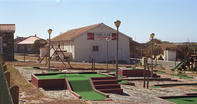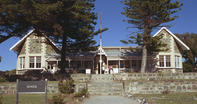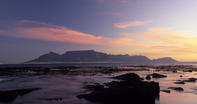The Village
Today, the village on Robben Island is home to 150 permanent residents. They consist of museum staff, prison guides, National Ports Authority employees, lighthouse keepers, Works Department personnel and a couple of die-hards from the old days. It is a small and isolated community, but it is enchanting.

The kids walk freely to each other’s houses, doors are left unlocked, time slows down to the point of irrelevance. The village contains about 100 houses, arranged in broad strips on either side of the main road. Each home has a dusty garden and a barrel for catching rain water.
Only 40 of them are currently inhabited, which makes the island rather spooky at night. Charlé, the post mistress, told me that she handles 2000 letters a month, and the island’s Post Office has won awards for its efficiency. The turreted Anglican Church, now Dutch Reformed, still has church services twice a month.
In the centre of the village is the Ledewinkel or community store. Here the locals get their supplies, and the kids drive the shopkeeper mad by constantly nagging for free sweets. The broad stoep of the shop also functions as a meeting place, with two plastic tables provided for afternoon chats. Next to the shop is a playground and an incongruous miniature-golf course (what South Africans call Putt-Putt). It was built for the prison warders’ entertainment, and it’s still in pretty good condition.
Comparatively Grand Buildings

A large swimming pool, behind a high wall, is where the kids usually spend their afternoons on the island; sunning themselves on the warm concrete and pushing each other into the water. The village also has a rugby field and a surreal cricket pitch, which was originally built by the British.
The island has a crèche and primary school, with 23 kids and 2 teachers. There is no high-school, so older kids either have to move to Cape Town or catch the daily staff ferry to the mainland. This can be a difficult commute, however, and there is one story of a matric pupil who couldn’t get to his final exam because the sea was too rough.
Apparently, the Air Force sent a helicopter to get him! At the southern end of the Village, facing the hazy shore of Bloubergstrand, is the Governor’s residence and the parsonage. These comparatively grand buildings date from the Victorian era, and now house the conference centre and the guest house (which is only open to invited guests).
Jaw-dropping Views

Once past the village, the road swings to the right and runs along the southern edge of the island, right along the coastline. The view is jaw-dropping. Across the channel, Table Mountain, Devil’s Peak and Lion’s Head rise up with preternatural force, dominating the island.
As you drive, the guide will point out Van Riebeeck’s old quarry, several WW2 rifle posts, the demolished military barracks, concrete WW2 lookouts and a recent shipwreck (the Fong Chung No. 11, which ran around in 1975). Unfortunately, the bus now turns off the perimeter road and drives up the modest slope of Minto Hill, towards the lighthouse.
Buck can usually be seen grazing on the thick grass at the foot of the hill, which soon gives way to a dense Bluegum plantation. At the crest of the hill stands the lighthouse. Built in 1865, it has a range of 24 sea miles and a 1.5 kW lamp. Its light is occulating, giving one flash of five seconds duration every seven seconds. It is the modern descendant of the signal fires that the Dutch used to light on this very same spot, over 300 years ago.
A radar station, the De Wall gun battery and a water desalination plant, which supplies the island with fresh water, are all close to the lighthouse. The bus continues over the hill, past the once-planned golf course and back into the village. At the top of the town, just visible from the road, is a second cemetery that contains the graves of officers and doctors who worked at the General Infirmary. Once you are back in the village, the bus turns left and heads back to the maximum-security prison.
By David Fleminger